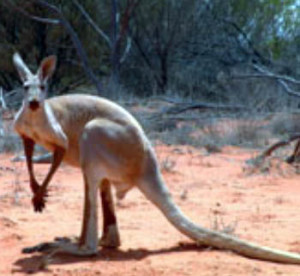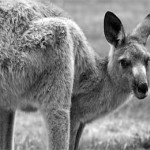Kangaroos and the Australian Environment & reason for culling
 This is where the kangaroo animal is put into perspective as far as the place in modern Australia goes.
This is where the kangaroo animal is put into perspective as far as the place in modern Australia goes.
“The Australian rangeland environment is fragile and easily degraded. Kangaroos have evolved as part of the Australian ecosystem and, with their soft feet, cause no environmental degradation at natural population levels.” Ref 1
This is a big part of the reason why using Kangaroo meat in Australia is a preferred option over other meat sources.
Recently a very controversial move has been made to open up some Victorian state alpine parks to horses again. These introduced species were originally banned in the parks because their hooves where destroying much of the pristine fragile ecosystems.
Similarly in many outback stations, whatever vegetation has been naturally available has often been trampled and killed by large cattle hooves and the like. The reason the Australian diet is based on cows, sheep and chickens (rather than kangaroo) is that it is still a hang-over from the colonial days when England colonized the country.
With that long history of consumption of farmed meats, it has been very difficult for the kangaroo industry to penetrate the Australian dinner table with any sufficient numbers.
This is why Australia still prefers farmed meat from introduced species to animals such as the native kangaroo, that by many measures would be much healthier for us to eat.
Of course this reluctance to eat kangaroo in large numbers in Australia opens up the opportunity for export of kangaroo meat to other countries, and the lower local demand keeps the prices down. Which of course is much better for people wanting to buy healthy kangaroo dog treats.
Why kangaroos are used as a food source
“Kangaroo populations have increased dramatically since European settlement in (Australia) due to the introduction of European farming methods and, for this reason, carefully controlled harvesting is required.” Ref 1
This is one of the hardest parts for people external to Australia to understand.
If kangaroos are on our coat of arms and so revered, how could we eat them or export them? True, kangaroo meat can be an acquired taste, it is naturally much ‘gamier’ than the relative sedate tastes of many commercially farmed introduced livestock. However, due to our expansive farming practices moving away from the coast and into more barren regions, many places that were originally difficult for humans and kangaroos to live in are now quite comfortable.
Extensive man-made irrigation means that many semi dessert regions are now able support large numbers of cattle, and if they can do that, they also inadvertently feed kangaroos and native wild life. New farming areas have permanently greened parts of Australia that were never exposed to such steady irrigation previously. This has lead to a large and unsustainable increase in kangaroo populations across Australia.
If the kangaroo meat is not eaten, it would be buried leading to a major waste of a prime resource.
Kangaroos and car accidents
If you search for information on kangaroos you might also come across kangaroo avoidance devices. These are often wind driven high frequency devices attached to cars to ward kangaroos away from roads.
It is true that kangaroos are rarely seen in urban regions in Australia, however if you drive either near dusk or dawn or at night time, in many regions there is a strong chance you will have a collision or a near miss with a kangaroo.
The reason for this seems to be that with Australia’s unreliable rainfall, when we do have rain, kangaroo and all other species populations tend to dramatically increase. Then when the rain and water sources dry up, many kangaroos are forced to travel long distances to find water, and many find pools of water and green vegetation by the side of roads.
If you have ever had a collision with a full sized adult male kangaroo, you will know the deadly consequences that can follow such collisions. There is very little protection that modern cars can use, and it seems that the kangaroo is often disorientated when they hear car horns and they can easily weave across a road. If you are travelling at highway speeds, this gives most people very little time to break and avoid a major accident.
THIS is another major reason why people who have to travel to rural regions, and who people who live in rural areas prefer kangaroo populations kept to manageable numbers.
CONCLUSIONS
The kangaroo is much better than introduced food-stock on the Australian vegetation, when they are capped at sustainable numbers.
The widespread farming and irrigation of Australia has brought kangaroos into areas previously not as populated by them, and caused population explosions. This plus the highway damage caused to cars and lives has meant that kangaroo are culled each year under a strict government licensing program.
Reference
Ref 1 http://www.dfat.gov.au/facts/kangaroos.html



online order itraconazole uk order
order itraconazole generic in usa